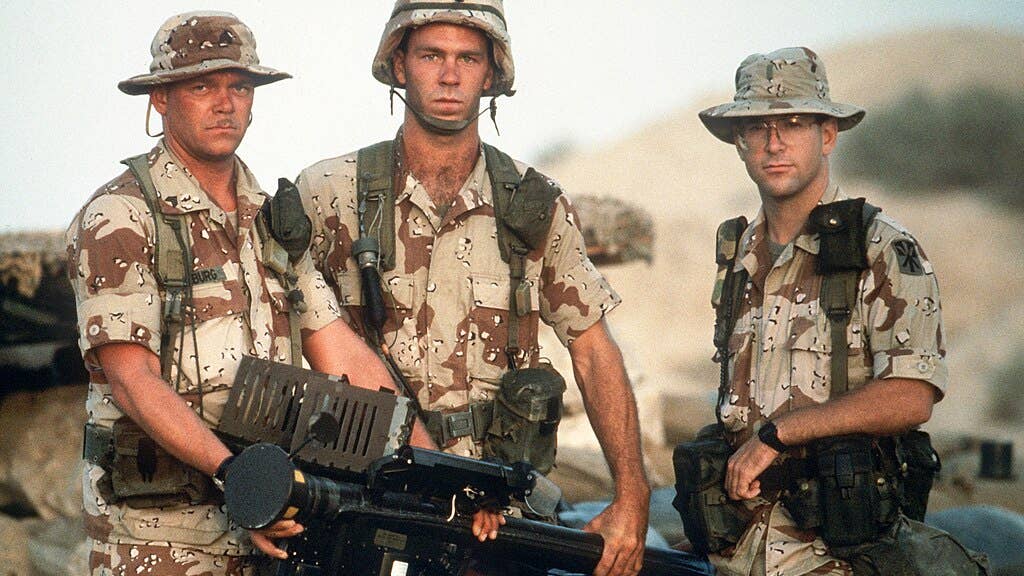Operation Desert Shield was the ultimate show of global strength

Members of Btry. A, 5162nd Air Defense Arty. Regt., 11th Air Defense Arty. Bde., hold an FIM-92A Stinger portable missile launcher as they pose for a photograph during Operation Desert Shield. (USAF PHOTO BY SSGT F. LEE CORKRAN DA-ST-92-06695)
SUMMARY
Today we’re diving into Operation Desert Shield, the 1990 answer to Iraq's less-than-neighborly invasion of Kuwait. This was the United States playing traffic cop to 34 nations, banding together like a multinational superhero squad, ready to protect Saudi Arabia from an overzealous Iraq looking to expand its sandbox.
A battalion of troops, enough to fill several sports stadiums, was posted up in the Arabian Peninsula, and the seas became a floating barricade around Iraq. The UN tried to play school principal, slapping Iraq's hand with resolutions and a stern look, but when the clock struck midnight on the agreed withdrawal deadline, the military fireworks of Operation Desert Storm began.
By the numbers
Operation Desert Shield was like a global family reunion, with 34 nations banding together against Iraq – almost as many as the countries competing in the FIFA World Cup! But let's not forget the naval blockade, the largest nautical gathering since World War II, that saw over 100 ships bobbing about, cutting off Iraq's sea routes.
On the ground, it was like the population of Atlanta - over half a million troops - decided to have a get-together in Saudi Arabia. More than 40,000 women served in the Gulf War, making it the largest deployment of female service members in history up until that time. As for the ground war, it was quick and dirty, lasting just 100 hours, like a military version of a speed run.
Now, oil and politics always make a potent cocktail, and after Iraq's invasion, it found itself controlling a cool 24% of the world's oil reserves. No wonder the world quickly went into "protect mode.” After the dust settled and the cease-fire declared, the troops were home faster than you give up your New Year's resolution, with most withdrawn within months.
And let's not forget Saddam Hussein, who post-war, was less a roaring lion and more a paper tiger, leading eventually to his ousting in 2003. Operation Desert Shield was like a high-stakes game with the world's peace on the line, and these impressive numbers certainly show how the world stepped up to the challenge.
A Game of Thrones, the Iraqi edition
We flash back to 1988, where Iraq's been grappling with Iran in the schoolyard and finding itself cash strapped. After essentially pulling an all-nighter in the War Room for two straight years, Iraq had a severe case of the budget blues. They tried to hit up Kuwait for some lunch money and oil price hikes, but when the negotiations fell flat, Saddam Hussein, the man of the hour, chose to occupy Kuwait.
Kuwait's defenses crumbled like a cookie in milk, and Hussein played dress-up, declaring himself the ruler while getting grabby with Kuwait's resources. Let's just say his actions weren't getting any Christmas cards from the international community. Countries like Egypt, Syria, Saudi Arabia and the United States quickly got their militaries into the gym, readying for a showdown. Four days post-invasion, the U.S. Congress even set a military intervention deadline: January 15, 1991.
Wrestling with diplomacy
The United Nations tried to slip into the role of peace broker, laying down resolutions and threatening force, but Saddam Hussein treated these resolutions like morning alarms – hitting the snooze button. Even economic sanctions were brushed off, prompting countries to dig their heels into the desert sand, readying over half a million troops for a rumble.
Operation Desert Shield was like the trailer before the main feature, Operation Desert Storm. With diplomacy out of the window, the United States hunkered down in Saudi Arabia, a goalie protecting against the potential shot on goal from Iraq. The unsuccessful negotiations signaled the whistle blow for Desert Storm, a six-week military blitz that ultimately led to Iraq's withdrawal.
Echoes of battle
Fast forward to today, the world's a whole new scene, but the ripple effects of Operation Desert Shield still surf the current of contemporary affairs. Let's decode the aftereffects. Desert Shield was like the big brother for Kuwait, warding off further bullying from Iraq. Kuwait, given time and protection, managed to rebuild its life. However, not all was rosy. The UN's iron-fist embargo against Iraq blocked the flow of goods, causing the Iraqi people to bear the brunt. Kuwait's once pristine land now sported the scars of oil spills and burning wells.
Iraq got a reality check post Operation Desert Shield. Saddam Hussein, now running on fumes, found his forces obliterated by the Avengers-level coalition. After a mere 100 hours of combat, Hussein had to swallow the bitter pill of a cease-fire.
Even though Hussein held onto his throne post-Gulf War, he was now more paper tiger than roaring lion. The UN sanctions had him boxed in, leading to the 2003 ousting of his regime.
Desert Shield, therefore, was a milestone moment, one that is still felt today. It shielded Kuwait from the bully, but also triggered decades of suffering for Iraqis and Kuwaitis. Its legacy continues to be the lens through which we view the Middle East.
SHARE
